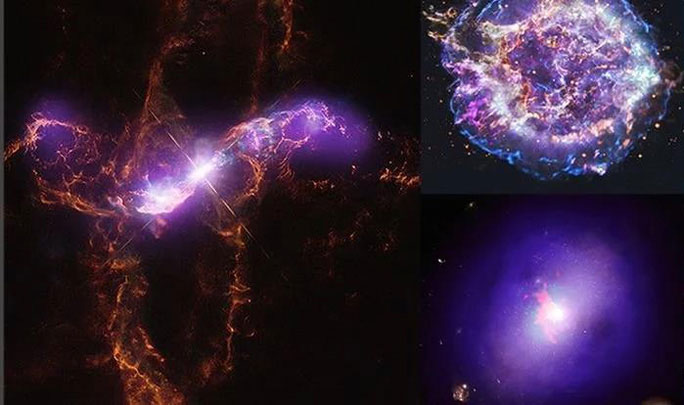The sky before your eyes may not be as serene as it seems: the Chandra X-ray Observatory and many telescopes around the Earth have recently captured stunning images of cosmic reapers tearing apart the sky in mesmerizing purple light.
One of these is R Aquarii, seen in purple X-ray light surrounded by a reddish-orange near-infrared halo. It turns out to be a binary star system locked in a deadly dance, consisting of a white dwarf (the “zombie” of a once-living star) that is “feeding” on its companion, a dying red giant star.

R Aquarii (left), Cassiopeia A (top right), and Abell 2597 (bottom right) are objects emitting intense X-rays invisible to the human eye – (Photo: NASA/STScI/NRAO/VLA/CXC/SAO).
The brutal feast of the white dwarf can sometimes trigger a colossal thermonuclear explosion, ejecting material into space and creating mesmerizing X-rays. This binary star system is located 650 light-years away from Earth, and if your eyes could see X-rays, you would be astounded by their display.
The second object is Cassiopeia A, located 11,000 light-years away, and is one of the most thoroughly studied objects in the Milky Way galaxy containing Earth.
However, with new data from Chandra, we are beginning to grasp the magnitude of this “monster.” It is the remnant of a supernova, appearing after a star exploded, ejecting a quantity of material that includes sulfur 10,000 times greater than all the sulfur on Earth, silicon 20,000 times greater, iron 70,000 times greater, and oxygen 1 million times greater than all the oxygen on our planet.
Additionally, there are other notable objects such as PSR B2224+65, a rapidly moving dead star that emits a terrifying X-ray tail; and Abell 2597, a galaxy cluster located 1 billion light-years away….
According to Science Alert, in addition to Chandra, scientists from NASA and various collaborating institutions have utilized several other telescopes with advanced observational tools to create the most complete images of these cosmic “reapers.”


















































